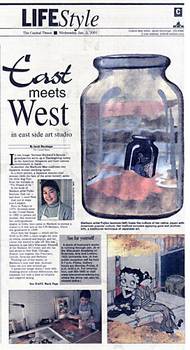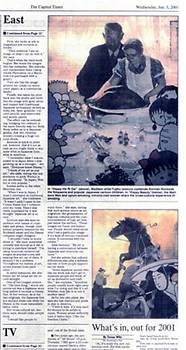East meets West
in east side art studio
By Jacob Stockinger
LIFE Style, The Capital Times, Madison, WI, January 3, 2001, C, 6C.
----In one image, Norman Rockwell's famous grandparents serve up a Thanksgiving turkey to the American Simpsons and their cartoon counterparts in Japan.
----In another, the Marlboro Man confronts two Japanese women smoking opium.
----In a third picture, a Japanese kimono-clad woman (with the face of the artist herself) saves the little dog Toto from the tornado in "The Wizard of Oz."
----In the work of Madison artist Fujiko Isomura, East can - and does - meet West.
----Just not in ways you'd expect.
----Born in Tokyo in 1970, Isomura came to the United States in 1992 to pursue art studies. She received her undergraduate degree in Iowa, then came to Madison to pursue a master's of fine arts at the UW-Madison, where she graduated in 1998.
----Since then her images - which sell for $500 to $1,000 - have caught the eyes of critics, curators and buyers, and her career has started to take off. She was featured in last fall's Wisconsin Triennial at the Madison Art Center, and she has had shows in New York, Chicago, Boston, Los Angeles, San Francisco, Lincoln, Syracuse and Berkeley.
----Working out of her studio on Madison's near east side, Isomura fuses old and new technology.
----A particular image doesn't start with thinking about cultural differences, she explains, but with a kind of intuitive and inspired seeing.
----First, she looks at ads in magazines and pictures in books.
----"Then suddenly I see an image of what I can do with it," she says.
----That's when the hard work begins. She scans the images into her computer. She reworks and manipulates them (using Adobe Photoshop on a Macintosh G4 purchased with a grant).
----Then she has the image printed out (inkjet on watercolor paper) at a commercial studio.
----Finally, she takes the print back into the studio and modifies the image with gold, silver and copper leaf (traditional Japanese techniques) as well as India ink, dyes, graphite, colored pencils, and watercolor and acrylic paints.
----The effect can be enthralling, bridging two cultures in the same friendly way her Betty Boop sidles up to a Japanese geisha: Just two chummy women crossing a huge cultural divide.
----Isomura is quick to point out, however, that it's not as easy as you might think to separate what is Japanese from what is American.
----"I remember what I was exposed to in Japan when I was growing up as a teenager," she says.
----"Everyone knew Disney."
----"I think of my art as pop art," she adds, noting that any similarity to Andy Warhol is not accidental. "In Japan, Warhol is very popular."
----Ironies arrive in the other direction, too.
----"When I was in Japan, I wasn't interested in traditional Japanese art," she confesses. "It wasn't until I came to the United States that I rediscovered my roots. Then I was really impressed by it and thought 'Japanese art is so cool.'"
----Isomura says she sees no problem with issues of copyright and piracy, though intellectual property lawyers for the Rockwell estate and the Disney company might disagree.
----"I shouldn't have to worry about it," she says, somewhat uneasily and almost as if she is trying to convince herself. "I'm using American commercial images as popular icons and making fine art out of them. It shouldn't be a problem. Throughout the history of art, artists learned from each other."
----In some instances, she also hopes her art helps set the record straight.
----One of her images centers on "The Lion King," which she points out was a Japanese story long before it became a Disney film. In her version, as in the two originals, the Japanese lion is a stylized white one while the Disney is the more naturalistic tawny color.
----Her cross-cultural art, Isomura says, should make people think.
----"I would like people to enjoy them, " she says, noting that such serious issues as immigration; the globalization of regional cultures and the commercialization of high art lurk just below the surface. "These images are funny and humorous. People should think about why I use a particular image. It's a kind of circular communication. It converses with the viewer."
----Adds Isomura:"My art is having a conversation between Japanese and American cultures."
----But she admits that cultural differences also play a substantial role in how people appreciate her work.
----"Some Japanese people who like my work just don't get it. Japanese people still think of art as decorative and craftlike, " she explains. "American people usually know right away what I'm doing and that it's art. Whether they like it or not is another issue."
----As for her own plans, she says she has married and plans to stay in America.
----"I love it here. It's very hard for women to be artists in Japan. Women artists definitely have it better here. I like the freedom I have."
(Please click on the article image to see the larger view.)
By Jacob Stockinger
LIFE Style, The Capital Times, Madison, WI, January 3, 2001, C, 6C.
----In one image, Norman Rockwell's famous grandparents serve up a Thanksgiving turkey to the American Simpsons and their cartoon counterparts in Japan.
----In another, the Marlboro Man confronts two Japanese women smoking opium.
----In a third picture, a Japanese kimono-clad woman (with the face of the artist herself) saves the little dog Toto from the tornado in "The Wizard of Oz."
----In the work of Madison artist Fujiko Isomura, East can - and does - meet West.
----Just not in ways you'd expect.
----Born in Tokyo in 1970, Isomura came to the United States in 1992 to pursue art studies. She received her undergraduate degree in Iowa, then came to Madison to pursue a master's of fine arts at the UW-Madison, where she graduated in 1998.
----Since then her images - which sell for $500 to $1,000 - have caught the eyes of critics, curators and buyers, and her career has started to take off. She was featured in last fall's Wisconsin Triennial at the Madison Art Center, and she has had shows in New York, Chicago, Boston, Los Angeles, San Francisco, Lincoln, Syracuse and Berkeley.
----Working out of her studio on Madison's near east side, Isomura fuses old and new technology.
----A particular image doesn't start with thinking about cultural differences, she explains, but with a kind of intuitive and inspired seeing.
----First, she looks at ads in magazines and pictures in books.
----"Then suddenly I see an image of what I can do with it," she says.
----That's when the hard work begins. She scans the images into her computer. She reworks and manipulates them (using Adobe Photoshop on a Macintosh G4 purchased with a grant).
----Then she has the image printed out (inkjet on watercolor paper) at a commercial studio.
----Finally, she takes the print back into the studio and modifies the image with gold, silver and copper leaf (traditional Japanese techniques) as well as India ink, dyes, graphite, colored pencils, and watercolor and acrylic paints.
----The effect can be enthralling, bridging two cultures in the same friendly way her Betty Boop sidles up to a Japanese geisha: Just two chummy women crossing a huge cultural divide.
----Isomura is quick to point out, however, that it's not as easy as you might think to separate what is Japanese from what is American.
----"I remember what I was exposed to in Japan when I was growing up as a teenager," she says.
----"Everyone knew Disney."
----"I think of my art as pop art," she adds, noting that any similarity to Andy Warhol is not accidental. "In Japan, Warhol is very popular."
----Ironies arrive in the other direction, too.
----"When I was in Japan, I wasn't interested in traditional Japanese art," she confesses. "It wasn't until I came to the United States that I rediscovered my roots. Then I was really impressed by it and thought 'Japanese art is so cool.'"
----Isomura says she sees no problem with issues of copyright and piracy, though intellectual property lawyers for the Rockwell estate and the Disney company might disagree.
----"I shouldn't have to worry about it," she says, somewhat uneasily and almost as if she is trying to convince herself. "I'm using American commercial images as popular icons and making fine art out of them. It shouldn't be a problem. Throughout the history of art, artists learned from each other."
----In some instances, she also hopes her art helps set the record straight.
----One of her images centers on "The Lion King," which she points out was a Japanese story long before it became a Disney film. In her version, as in the two originals, the Japanese lion is a stylized white one while the Disney is the more naturalistic tawny color.
----Her cross-cultural art, Isomura says, should make people think.
----"I would like people to enjoy them, " she says, noting that such serious issues as immigration; the globalization of regional cultures and the commercialization of high art lurk just below the surface. "These images are funny and humorous. People should think about why I use a particular image. It's a kind of circular communication. It converses with the viewer."
----Adds Isomura:"My art is having a conversation between Japanese and American cultures."
----But she admits that cultural differences also play a substantial role in how people appreciate her work.
----"Some Japanese people who like my work just don't get it. Japanese people still think of art as decorative and craftlike, " she explains. "American people usually know right away what I'm doing and that it's art. Whether they like it or not is another issue."
----As for her own plans, she says she has married and plans to stay in America.
----"I love it here. It's very hard for women to be artists in Japan. Women artists definitely have it better here. I like the freedom I have."
(Please click on the article image to see the larger view.)


